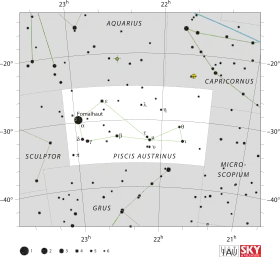Theta Piscis Austrini
Theta Piscis Austrini, Latinized as θ Piscis Austrini, is a binary star[8] system in the southern constellation of Piscis Austrinus. It is faintly visible to the naked eye with a combined apparent visual magnitude of +5.01.[2] Based upon an annual parallax shift of 10.16 mas as seen from the Earth,[1] the system is located around 320 light years from the Sun. The system is drifting further away with a radial velocity of +13 km/s.[4]
 | |
| Observation data Epoch J2000.0 Equinox J2000.0 (ICRS) | |
|---|---|
| Constellation | Piscis Austrinus |
| Right ascension | 21h 47m 44.14993s[1] |
| Declination | −30° 53′ 53.9027″[1] |
| Apparent magnitude (V) | +5.01[2] |
| Characteristics | |
| Spectral type | A1 V + A1 V[3] |
| B−V color index | +0.04[2] |
| Astrometry | |
| Radial velocity (Rv) | +12.80±1.8[4] km/s |
| Proper motion (μ) | RA: −34.40[1] mas/yr Dec.: −0.08[1] mas/yr |
| Parallax (π) | 10.16 ± 0.40 mas[1] |
| Distance | 320 ± 10 ly (98 ± 4 pc) |
| Absolute magnitude (MV) | +0.06[5] |
| Orbit[3] | |
| Period (P) | 19.957±0.050 yr |
| Semi-major axis (a) | 0.137±0.004″ |
| Eccentricity (e) | 0.256±0.030 |
| Inclination (i) | 103±2° |
| Longitude of the node (Ω) | 29.1±2.0° |
| Periastron epoch (T) | 2006.00 ± 0.07 |
| Argument of periastron (ω) (secondary) | 199±6° |
| Details | |
| θ PsA A | |
| Mass | 2.32±0.33[3] M☉ |
| Luminosity | 86[5] L☉ |
| Surface gravity (log g) | 4.05[6] cgs |
| Temperature | 9,716±330[6] K |
| Rotational velocity (v sin i) | 150[6] km/s |
| Age | 281[6] Myr |
| θ PsA B | |
| Mass | 2.32±0.33[3] M☉ |
| Other designations | |
| Database references | |
| SIMBAD | data |
The binary nature of this system was discovered in 1951 by South African astronomer W. S. Finsen. Both components A and B have the same apparent magnitude. They orbit each other with a period of 20 years and an eccentricity of 0.256. The pair are A-type main sequence stars with stellar classifications of A1 V.[3] A magnitude 11.3 visual companion star, labelled component C, is located at an angular separation of 33.2 arc seconds along a position angle of 342°, as of 1999.[9]
Theta Piscis Austrini is moving through the Galaxy at a speed of 21.3 km/s relative to the Sun. Its projected Galactic orbit carries it between 22,629 and 38,431 light-years from the center of the Galaxy. Theta Piscis Austrini came closest to the Sun 2.7 million years ago at a distance of 256 light-years.[5]
Naming
In Chinese, 天錢 (Tiān Qián), meaning Celestial Money, refers to an asterism consisting of refers to an asterism consisting of θ Piscis Austrini, 13 Piscis Austrini, ι Piscis Austrini, μ Piscis Austrini and τ Piscis Austrini. Consequently, the Chinese name for θ Piscis Austrini itself is 天錢二 (Tiān Qián èr, English: the Second Star of Celestial Money.)[10]
References
- van Leeuwen, F. (2007), "Validation of the new Hipparcos reduction", Astronomy and Astrophysics, 474 (2): 653–664, arXiv:0708.1752, Bibcode:2007A&A...474..653V, doi:10.1051/0004-6361:20078357, S2CID 18759600.
- Nicolet, B. (1978), "Photoelectric photometric Catalogue of homogeneous measurements in the UBV System", Astronomy and Astrophysics Supplement Series, 34: 1–49, Bibcode:1978A&AS...34....1N.
- Docobo, J. A.; Andrade, M. (2013), "Dynamical and physical properties of 22 binaries discovered by W. S. Finsen", Monthly Notices of the Royal Astronomical Society, 428 (1): 321–339, Bibcode:2013MNRAS.428..321D, doi:10.1093/mnras/sts045.
- Kharchenko, N. V.; et al. (2007), "Astrophysical supplements to the ASCC-2.5: Ia. Radial velocities of ˜55000 stars and mean radial velocities of 516 Galactic open clusters and associations", Astronomische Nachrichten, 328 (9): 889, arXiv:0705.0878, Bibcode:2007AN....328..889K, doi:10.1002/asna.200710776, S2CID 119323941.
- Anderson, E.; Francis, Ch. (2012), "XHIP: An extended hipparcos compilation", Astronomy Letters, 38 (5): 331, arXiv:1108.4971, Bibcode:2012AstL...38..331A, doi:10.1134/S1063773712050015, S2CID 119257644.
- David, Trevor J.; Hillenbrand, Lynne A. (2015), "The Ages of Early-Type Stars: Strömgren Photometric Methods Calibrated, Validated, Tested, and Applied to Hosts and Prospective Hosts of Directly Imaged Exoplanets", The Astrophysical Journal, 804 (2): 146, arXiv:1501.03154, Bibcode:2015ApJ...804..146D, doi:10.1088/0004-637X/804/2/146, S2CID 33401607.
- "tet PsA -- Double or multiple star", SIMBAD Astronomical Database, Centre de Données astronomiques de Strasbourg, retrieved 2017-05-18.
- Eggleton, P. P.; Tokovinin, A. A. (September 2008), "A catalogue of multiplicity among bright stellar systems", Monthly Notices of the Royal Astronomical Society, 389 (2): 869–879, arXiv:0806.2878, Bibcode:2008MNRAS.389..869E, doi:10.1111/j.1365-2966.2008.13596.x, S2CID 14878976.
- Mason, B. D.; et al. (2014), "The Washington Visual Double Star Catalog", The Astronomical Journal, 122 (6): 3466, Bibcode:2001AJ....122.3466M, doi:10.1086/323920, retrieved 2015-07-22
- (in Chinese) AEEA (Activities of Exhibition and Education in Astronomy) 天文教育資訊網 2006 年 7 月 5 日